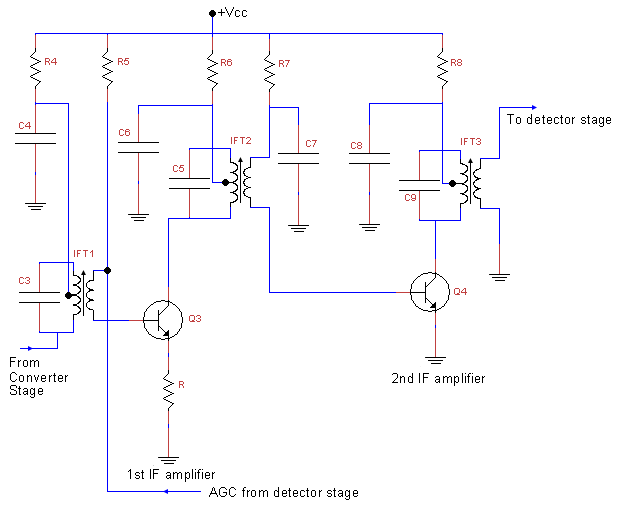AM Communication Receiver
The receiving antenna intercepts the electromagnetic radiations and converts them into RF voltage. The RF signal is then applied to the RF amplifier through the antenna coupling, network, which matches the impedances of the antenna and the RE amplifier. The RF amplifier amplifies this signal, which lies in the frequency range of 2 - 30 MHz. The amplified signal is fed to the first mixer, where it is mixed with the locally generated signal. The frequency of the local oscillator, f01 is 650 kHz above the frequency the receiver signal, fs. Thus, the frequency range of the first local oscillator is (fs + 650 kHz). The first local oscillator and the RF amplifier are ganged together to generate the correct oscillator frequency.

The mixer circuit generates an IF signal whose frequency is 650 kHz. This IF signal is amplified by the first IF amplifier.
After amplification, the IF signal is given to the second mixer, which mixes this signal with another locally generated signal generated by the second oscillator. The frequency of the second local oscillator is fixed at 500 kHz. As this frequency is fixed, a crystal oscillator is used in this stage to have good frequency stability.
The second mixer generates the second IF signal. The value of the second IF frequency is 150 kHz, as it is the difference between the first IF frequency (650 kHz) and the second local oscillator frequency (500 kHz). The frequency of the second IF frequency is kept below the usual IF frequency of the AM receiver which is 455 kHz. The frequency of the first IF signal is kept above 455 kHz, up to a value of 650 kHz. With this arrangement, the communication receiver has the advantages of both low and high IF frequency. This technique of using two frequencies is known as double conversion.
The second IF signal is now applied to the second IF amplifier, which amplifies it to the required value so that the signal is satisfactorily detected. The detector stage demodulates the received signal and gives its output as the modulating signal, which is an audio signal. This audio signal is then amplified by the audio stages which consist of the audio driver amplifier and the audio output power amplifier. The audio signal is then given to the speaker, which produces the sound.
To control the gains of the amplifiers of the system, AGC is employed. The AGC voltage is used to keep the volume of the receiver constant to the level set by the listener. The output of the second IF amplifier is also given to the AGC detector, as shown in Figure (a). The AGC detector produces a dc voltage, called the AGC bias voltage, which is proportion to the carrier strength of the received signal. The signal is also amplified by the AG amplifier before being detected to generate the AGC bias voltage. The AGC bias voltage generated is applied to the RF amplifier and first IF amplifier, to control their gains.In addition to the above-mentioned sections of the AM communication receiver, communication receiver has additional features that described next.
Seat Frequency Oscillator (BFO)
Communication receivers can also receive telegraphic signals that use Morse code, which is a pulse-modulated RF carrier signal. Morse code is transmitted as dots, dashes, and spaces. These are distinguished by different carrier frequencies with constant amplitude. A normal diode detector used in an AM system is not capable of distinguishing the presence or absence of a carrier signal, which is the usual technique to transmit Morse code. For example, the absence of a carrier signal may represent a space in the Morse code.
To detect Morse code, a simple LC oscillator, which generates a constant frequency of 1 KHz or 400 Hz above or below the second IF frequency, is provided in the system. The LC oscillator is known as the BFO.. The output of the BFO is applied to the second IF amplifier as its second input. The second IF signal and the output of the BFO together generate whistles that indicate the presence of a dot, a dash, or a space. A switch is provided in the receiver to select the option of receiving an audio signal or a telegraph signal. This switch is in the off position when telegraph signals are not received. This provision is known as variable selectivity.
Squeltch or Muting
When the communication transmitter does not transmit any signal, the receiver receives only the noise present at its input. A good quality communication receiver can amplify this noise to produce a very loud noise from the speaker. The main reason behind this loud noise is that the AGC bias voltage which is proportion to the carrier strength is absent. In the absence of the RF signal. Thus, the gains of the RF and IF amplifiers are not controlled, and they provide maximum to the noise.
The communication receivers used by police, ambulances, and coast guard radio stations are continuously operated. In these receivers, it is necessary to control the noise level in the absence of a carrier signal, as it will irritate the user. This is done by providing a Squeltch or muting circuit in the system.
The output of the AGC detector is also applied to the squeltch circuit, as shown in Figure (a). In the absence of a carrier, the AGC detector does not generate the AGC bias voltage. The squeltch circuit, in this condition, cuts off the audio amplifier stages to block the noise signal to the speaker. As soon as the carrier signal is received, the AGC voltage is generated and the audio amplifiers work as normal.
Metering (Tuning Indicator)
Tuning indicator is provided in the receiver so that the operator knows if the receiver is tuned to the correct signal frequency. This process is also called metering of the strength of the received signal. The tuning indicator is either a set of light emitting diodes (LEDs) or an electronic meter, called an S-Meter. When the receiver is tuned to the correct signal frequency, both the side bands of the received signal are well accommodated and the detector generates a dc component. This dc component is proportional to the received carrier strength. The tuning indicator uses the dc component to indicate the strength of the received signal. The receiver is tuned until the tuning indicator indicates the maximum possible value for the desired tuned signal.
Double Conversion
In the double conversion technique, two intermediate frequencies are generated instead of then single intermediate frequency used in commercial AM receivers. In addition, this technique uses two local oscillators and two mixers, as shown in Figure (a).
The first local oscillator is a variable frequency oscillator that can generate an IF frequency of 650 kHz. It is ganged with the RF amplifier to generate the correct local oscillator frequency so that the mixer gives an output 650 kHz.
The second local oscillator is a crystal oscillator that generates a fixed frequency signal of 500 kHz. Therefore, the input to the second mixed is also a fixed IF frequency, and hence there is no need for a variable local oscillator frequency. The second mixer generates an IF signal at 150 kHz.
The two basic reasons for double conversion are:
- It provides advantages of having both higher and lower IF frequencies.
- It provides a higher image frequency rejection.
Due to these reasons, double conversion has become popular in communication receivers. Another technique called up-conversion, explained next, also though to get better selectivity of the receiver.
Up-Conversion
The conversion technique generates an IF with a frequency above the signal frequency. In conversion, IF frequency may have a value of 40 MHz for a signal frequency hand of 2-30 MHz. The local oscillator frequency in this case will be (fs + 40 MHz).
In AM receivers, IF frequency is kept lower than the signal frequency: This lower signal is used because capacitors and inductors arc available for selectivity networks, called filters, at lower frequencies. The invention of crystal and ceramic filters at very high frequencies provides an opportunity to adopt IF frequency higher than the signal frequencies. Thus, the up-conversion technique has become very popular in communication receivers due to the availability of good filters operated at higher frequencies.
Automatic Gain Control (AGC)
In communication receivers, the simple AGC technique discussed in AM receivers is not employed. This is because the simple AGC also reduces the gain of the amplifiers for the weak signals. In communication receivers, improved AGC techniques are used so that the weak signals are satisfactorily processed. The two techniques or AGC that are employed in communication receivers are:
- Delayed ACC
- Auxiliary AGC
Delayed AGC
In delayed AGC, the AGC remains inoperative below a predetermined input carrier voltage. If predetermined level, it is considered a weak signal. The received signal strength is below the predetermined level, it is considered a weak signal. The AGC bias voltage is applied to the RF and IF amplifiers only if the level or input carrier voltage goes above this predetermined level. In other words, the AGC is delayed in applying the bias voltage to the amplifiers the bias voltage to the amplifier for a certain predetermined level.

A typical circuit diagram of a delayed AGC is illustrated in Figure (b). In delayed AGC, the output of the last IF amplifier, which is the second IF amplifier shown in Figure (a), is taken through a coupling capacitor, Cc. This is applied to a diode, D1. The cathode of diode D1 is provided with a positive dc voltage, Vdc, through a variable resistor, R. This sets the predetermined level up to which the AGC is not to be applied. If the received signal is weak, the anode voltage of the diode is less than the cathode voltage, and is reverse-biased. This results in the diode not conducting. The received signal thus goes to R1, R2, and C1 networks, as shown in Figure (b). This is an AC signal and passes through C1. Thus, no dc voltage is available for AGC and the amplifiers operate at their usual gains.
When a strong signal is received, the anode voltage goes above the cathode voltage of the diode, and the diode starts conducting. The signal, passed to capacitor C1 in this condition, gets negative peaks and filters them. This results in a constant negative voltage, which is used as a delayed AGC and applied, to the RF and IF amplifiers. The variable resistor, R can adjust the level of delay AGC. This control is given at the panel of the receiver so that the operator can adjust the delayed AGC level according to the signal conditions. If a weak signal is received, then the operator can adjust it so that no AGC is applied.
AGC Characteristics Curves
A comparison between simple AGC and delayed AGC is shown in Figure (c). A curve is also drawn for an ideal AGC.

These curves are also compared with the generated when AGC is not applied. An ideal AGC provides a constant output signal level for all input carrier signals, after a particular input level, marked as A in Figure (c). Up to point A, the output level linearly increases with the input carrier signal. A simple AGC continuously increases with an increase in the input carrier signal. Thus, there is no control on the output signal level for a simple AGC. On the other hand, the characteristic curve for delayed AGC shows that it is very close to the ideal AGC.
Auxiliary AGC
In communication receivers, an auxiliary AGC is provided in addition to the delayed AGC. The auxiliary AGC becomes operative for very strong signals. The auxiliary AGC circuit includes only one diode, which is connected between the collector of the first IF amplifier, Q3, and the collector of the converter, Q4, as shown in Figure (d).

The anode of the diode is connected to the collector of the IF amplifier and the cathode is connected to the collector of the convertor. When the signal is not strong the diode is reverse biased and does not affect the normal operation of the circuit. When a very strong signal is received, the diode becomes forward biased and starts conducting. The diode resistances lowers and it loads the first IFT and capacitor C3, as shown in Figure (d). This circuit is connected to the base of first 1F amplifier, and its gain reduces due to the loading of IFT1 and C3. This accordingly reduces the output signal level. The auxiliary AGC provides another means to reduce the gain of the IF amplifier in the presence of strong signals.
Variable Sensitivity
Some highly sophisticated communication receivers provide a manual control of AGC that is accessible to the operator. This is called a variable sensitivity control. The operator can adjust the gain of the IF and RF amplifiers so that the receiver can amplify very weak signals to a satisfactory level. This sensitivity control also helps in adjusting the output of the receiver according to the comfort of the operator.
Variable Selectivity
In the block diagram of a communication receiver shown in Figure (a), a BFO is included to receive telegraph signals. In some communication receivers, provisions are also made to receive some other signals, such as SSB, normal AM, and FM signals. This provision is called variable selectivity. It is obvious that such a receiver is complex and costly, however these factors are somewhat reduced by sharing circuits for certain communications systems. For example, local oscillator and RF amplifiers may be shared by all the systems provided in the receiver. Variable selectivity makes the communication receiver behave as a multi-purpose receiver.
Noise Limiting
The noise in receiver conies from two sources, external and internal. The internal noise is generated by the components in the receiver, and is taken care of by the SNR factor. However, after a certain threshold, external noise becomes difficult for an operator to withstand.
The external noise consists of two components:
- A continuous noise component, called background noise. which has an almost fixed level rot- a given location, and can be tolerated.
- An impulsive noise component that comes from man-nude sources, such as high current loads and ignition systems of vehicles. It may also come from lightning.
The impulsive noise can be thousands times stronger than the received signal, and totally mask the signal by producing a highly intolerable noise at the speaker. Once the receiver picks up this noise, there is no other alternative than to cut off the audio from the previous stages. This is done by noise limiting circuit that become, operative only when a high-level noise is received.
The noise limiting circuit silences the receiver until the noise impulse decreases to a predetermined level. This circuit is called Automatic Noise Limiter (ANL).
Performance Parameters of Communication Receivers
In addition to the sensitivity, selectivity and image-rejection ratio parameters, the performance of a communication receiver depends on:
- Dynamic range
- Third-order intercept
- Noise floor
The dynamic range of receiver is defined as the range of the input power over which a predetermined output power is obtained. This identifies the minimum input power of the receiver that can produce a useful output power. The upper and lower limits of the dynamic range of the receiver are affected by the inter-modulation distortion and the noise present at the output of the receiver.
Inter-modulation distortions are produced by the generation of higher harmonics and their sum and difference components. The second-order inter-modulation components, such as (f1 + f2), (f1 - f2), 2f1, and 2f2, when frequencies f1 and f2 are received, do not present problems, as they lie outside the pass-band of the receiver. However, third-order inter-modulation components, such as (2f1 +f2) and (2f2+ f1) lie within the pass-band of the receiver and introduce heavy distortions in the output. This is known as the third-order intercept. To minimize the effects of this intercept, MOSFETs are used in RF and mixer stages of the receiver.
The noise floor of a receiver is defined as the amount of noise present at the output of the receiver. This factor is very important as it affects the output SNR of the receiver. It also affects the dynamic range of the receiver, because it may render the output unintelligible if the level is too high. The dynamic range of a receiver is expressed in terms of the third-order intercept and noise floor as:
Dynamic Range (dB) = 2/3 (Third-order intercept (db) - Noise Floor (dB))
